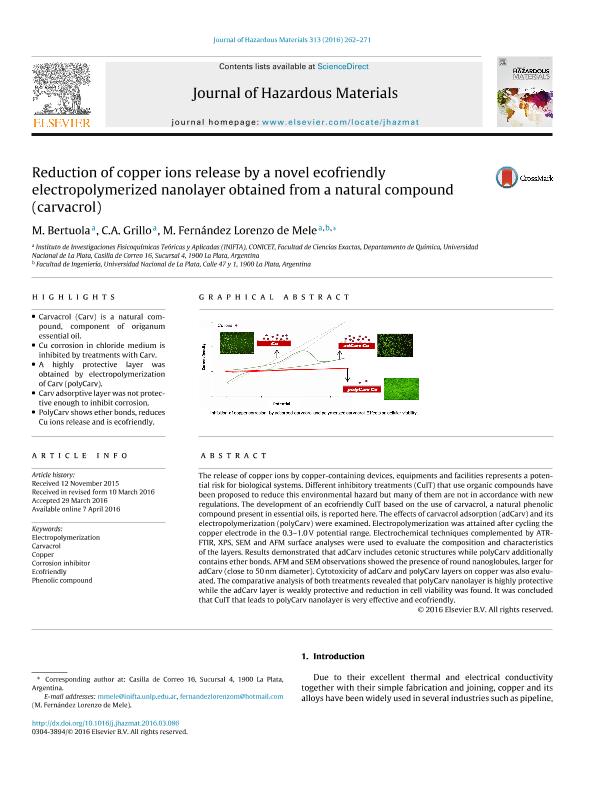Mostrar el registro sencillo del ítem
dc.contributor.author
Bertuola, Marcos

dc.contributor.author
Grillo, Claudia Alejandra

dc.contributor.author
Fernandez Lorenzo, Monica Alicia

dc.date.available
2018-06-14T21:39:30Z
dc.date.issued
2016-08
dc.identifier.citation
Bertuola, Marcos; Grillo, Claudia Alejandra; Fernandez Lorenzo, Monica Alicia; Reduction of copper ions release by a novel ecofriendly electropolymerized nanolayer obtained from a natural compound (carvacrol); Elsevier Science; Journal of Hazardous Materials; 313; 8-2016; 262-271
dc.identifier.issn
0304-3894
dc.identifier.uri
http://hdl.handle.net/11336/48737
dc.description.abstract
The release of copper ions by copper-containing devices, equipments and facilities represents a potential risk for biological systems. Different inhibitory treatments (CuIT) that use organic compounds have been proposed to reduce this environmental hazard but many of them are not in accordance with new regulations. The development of an ecofriendly CuIT based on the use of carvacrol, a natural phenolic compound present in essential oils, is reported here. The effects of carvacrol adsorption (adCarv) and its electropolymerization (polyCarv) were examined. Electropolymerization was attained after cycling the copper electrode in the 0.3-1.0 V potential range. Electrochemical techniques complemented by ATR-FTIR, XPS, SEM and AFM surface analyses were used to evaluate the composition and characteristics of the layers. Results demonstrated that adCarv includes cetonic structures while polyCarv additionally contains ether bonds. AFM and SEM observations showed the presence of round nanoglobules, larger for adCarv (close to 50 nm diameter). Cytotoxicity of adCarv and polyCarv layers on copper was also evaluated. The comparative analysis of both treatments revealed that polyCarv nanolayer is highly protective while the adCarv layer is weakly protective and reduction in cell viability was found. It was concluded that CuIT that leads to polyCarv nanolayer is very effective and ecofriendly.
dc.format
application/pdf
dc.language.iso
eng
dc.publisher
Elsevier Science

dc.rights
info:eu-repo/semantics/openAccess
dc.rights.uri
https://creativecommons.org/licenses/by-nc-sa/2.5/ar/
dc.subject
CARVACROL
dc.subject
COPPER
dc.subject
CORROSION INHIBITOR
dc.subject
ECOFRIENDLY
dc.subject
ELECTROPOLYMERIZATION
dc.subject
PHENOLIC COMPOUND
dc.subject.classification
Biotecnología Industrial

dc.subject.classification
Biotecnología Industrial

dc.subject.classification
INGENIERÍAS Y TECNOLOGÍAS

dc.title
Reduction of copper ions release by a novel ecofriendly electropolymerized nanolayer obtained from a natural compound (carvacrol)
dc.type
info:eu-repo/semantics/article
dc.type
info:ar-repo/semantics/artículo
dc.type
info:eu-repo/semantics/publishedVersion
dc.date.updated
2018-06-14T19:07:56Z
dc.journal.volume
313
dc.journal.pagination
262-271
dc.journal.pais
Países Bajos

dc.journal.ciudad
Amsterdam
dc.description.fil
Fil: Bertuola, Marcos. Consejo Nacional de Investigaciones Científicas y Técnicas. Centro Científico Tecnológico Conicet - La Plata. Instituto de Investigaciones Fisicoquímicas Teóricas y Aplicadas. Universidad Nacional de La Plata. Facultad de Ciencias Exactas. Instituto de Investigaciones Fisicoquímicas Teóricas y Aplicadas; Argentina
dc.description.fil
Fil: Grillo, Claudia Alejandra. Consejo Nacional de Investigaciones Científicas y Técnicas. Centro Científico Tecnológico Conicet - La Plata. Instituto de Investigaciones Fisicoquímicas Teóricas y Aplicadas. Universidad Nacional de La Plata. Facultad de Ciencias Exactas. Instituto de Investigaciones Fisicoquímicas Teóricas y Aplicadas; Argentina
dc.description.fil
Fil: Fernandez Lorenzo, Monica Alicia. Consejo Nacional de Investigaciones Científicas y Técnicas. Centro Científico Tecnológico Conicet - La Plata. Instituto de Investigaciones Fisicoquímicas Teóricas y Aplicadas. Universidad Nacional de La Plata. Facultad de Ciencias Exactas. Instituto de Investigaciones Fisicoquímicas Teóricas y Aplicadas; Argentina. Universidad Nacional de La Plata. Facultad de Ingeniería; Argentina
dc.journal.title
Journal of Hazardous Materials

dc.relation.alternativeid
info:eu-repo/semantics/altIdentifier/url/http://www.sciencedirect.com/science/article/pii/S0304389416303090
dc.relation.alternativeid
info:eu-repo/semantics/altIdentifier/doi/http://dx.doi.org/10.1016/j.jhazmat.2016.03.086
Archivos asociados
